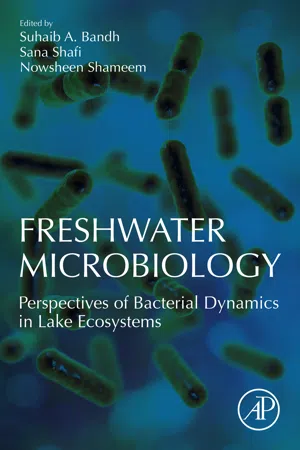
Freshwater Microbiology
Perspectives of Bacterial Dynamics in Lake Ecosystems
- 450 pages
- English
- ePUB (mobile friendly)
- Available on iOS & Android
About This Book
Freshwater Microbiology: Perspectives of Bacterial Dynamics in Lake Ecosystems provides a comprehensive and systematic analysis of microbial ecology in lakes. It offers basic information on how well the bacterial community composition varies along the spatio-temporal and trophic gradients along with the evaluation of the bioindicator species of bacteria so as to act as a key to predict the trophic status of lake ecosystems. The book helps to identify the factors of potential importance in structuring the bacterial communities in lakes as it delves into the dynamics and diversity of bacterial community composition in relation to various water quality parameters. It helps to identify the possibility of bioremediation plans and devising future policy decisions, with better conservation and management practices.
- Provides a comprehensive and systematic analysis of microbial ecology
- Helps to identify the factors of potential importance in structuring the bacterial community composition
- Gives insight into the bacterial diversity of freshwater lake ecosystems along with their industrial potential
- Caters to the needs and aspirations of students and professional researchers
Frequently asked questions
Information
Bacterial community composition in lakes
Abstract
Keywords
Introduction
Table of contents
- Cover image
- Title page
- Table of Contents
- Copyright
- List of contributors
- Preface
- Acknowledgments
- Chapter 1. Bacterial community composition in lakes
- Chapter 2. Bacterial diversity of the rock-water interface in freshwater ecosystem
- Chapter 3. Impact of environmental changes and human activities on bacterial diversity of lakes
- Chapter 4. Spatio-temporal patterns of bacterial diversity along environmental gradients and bacterial attachment to organic aggregates
- Chapter 5. Metagenomic insights into the diversity and functions of microbial assemblages in lakes
- Chapter 6. Depth distribution of microbial diversity in lakes
- Chapter 7. Exploring bacterial diversity: from cell to sequence
- Chapter 8. Bacterial biofilms: the remarkable heterogeneous biological communities and nitrogen fixing microorganisms in lakes
- Chapter 9. Microbial diversity in freshwater ecosystems and its industrial potential
- Chapter 10. Bacteria: the natural indicator of environmental pollution
- Index